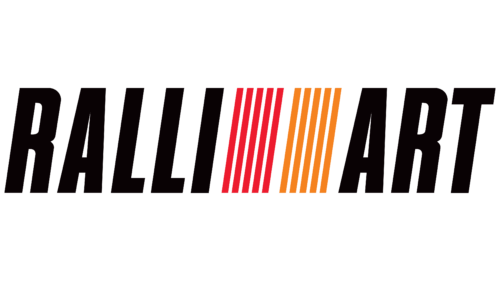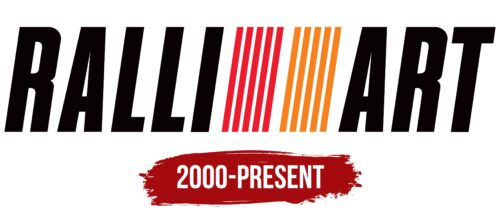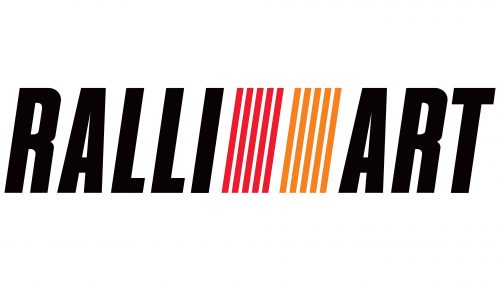The Ralliart logo is a graphic art that reflects the art of racing, which values endurance and speed. This is fully represented in the emblem, which serves as a symbol of the brand’s identity.
Ralliart: Brand overview
The story of Ralliart began in April 1984, when celebrated racer Andrew Cowan and his colleague Doug Stewart founded the company in Tokyo, Japan. This motorsport division of Mitsubishi Motors was dedicated to preparing rally cars and participating in various motorsport events.
In 1984, the brand started by preparing Mitsubishi vehicles for rally competitions. By 1985, the brand debuted with the Mitsubishi Starion in the World Rally Championship (WRC). The company achieved its first significant success in 1987 when Kenneth Eriksson secured third place in the Swedish Rally driving a Mitsubishi Galant VR-4.
The brand expanded its operations by opening a European division, Ralliart Europe, in 1988. Success continued in 1990, with the Mitsubishi Galant VR-4 winning the Asia-Pacific Rally Championship.
1992, the brand began participating in the Dakar Rally with the Mitsubishi Pajero. The following year, Bruno Saby won the brand’s first Dakar Rally. This period also saw the introduction of the legendary Mitsubishi Lancer Evolution in 1995, which became the cornerstone for future successes in the WRC.
From 1996 to 1998, Tommi Mäkinen won three consecutive WRC championships, driving a Mitsubishi Lancer Evolution prepared by the brand. This winning streak continued in 1999, securing a fourth consecutive championship title for Mäkinen and Mitsubishi. During the same period, the brand continued to dominate the Dakar Rally, achieving multiple victories with various drivers.
Entering the new millennium, the brand faced new challenges and underwent restructuring. 2001, the brand began producing and selling tuning kits and accessories for Mitsubishi road cars. However, 2003 marked the last victory for Mitsubishi in the WRC at the Monte Carlo Rally with driver Gilles Panizzi. By 2005, Mitsubishi announced its withdrawal from the WRC, significantly reducing its activities in this area.
Despite this, the brand continued its success in the Dakar Rally, with the last victory in 2007, marking Mitsubishi’s twelfth consecutive win in this grueling event. However, by 2009, financial difficulties forced Mitsubishi Motors to scale back the brand’s operations significantly. In 2010, the brand ceased to exist as a separate division within Mitsubishi Motors.
From 2011 to 2020, the brand’s activities were mostly limited to producing and selling tuning parts and accessories for Mitsubishi vehicles, with minimal participation in motorsports.
In 2021, Mitsubishi Motors announced plans to revive the brand. By 2022, new concept cars were introduced under the revived brand, signaling Mitsubishi’s intent to return to its motorsport roots.
Throughout history, the brand has contributed to rally sports and created sporty versions of Mitsubishi road cars. The company achieved remarkable success in the WRC and the Dakar Rally, enhancing Mitsubishi’s reputation as a manufacturer of reliable and sporty vehicles.
Meaning and History
What is Ralliart?
It is the high-performance and motorsport division of Mitsubishi Motors. The company is known for its involvement in rally racing and other motorsports, and specializes in the development of high-performance vehicles and aftermarket parts. The products feature upgraded engines, suspensions and aerodynamics, reflecting the brand’s commitment to excellence and innovation in motorsport.
2000 – today
The Ralliart logo has a simple shape: a single-line horizontal sign with text and speed lines. It conveys the sophisticated style of driving luxurious sports cars, which the manufacturer proudly stands for, and is familiar with the techniques of high-speed racing. The emblem reflects the idea that racing is an art mastered only by a select few, those with innate talent or those driving cars of this brand.
The brand name is set in uppercase, smooth, sans-serif strokes, indicating that:
- The company prefers minimalism in visual identity for quick and precise perception.
- The cars perform perfectly on any track, facing no difficulties or obstacles in moving forward confidently.
- The cars are easy to handle and trouble-free, eagerly overcoming obstacles and swiftly gliding down the racetrack.
The smooth edges convey this glide, hinting at the excellent technical condition of professional sports cars. The right-leaning glyphs reflect the speed with which they race down the road. The italic style symbolizes the unstoppable energy and ever-growing dynamics inherent in all Ralliart models.
The letters are elegant, tall, grotesque, and bold, yet readability remains unaffected: the text is visible regardless of the background. The boldness of the glyphs does not detract from the elegant style, as the letters are elongated, effectively hiding their “fullness.” This graphic approach confirms the automotive company’s concept that racing cars are the epitome of elegance, where internal components and external appearance matter, attracting attention and quickening the hearts of fans cheering for their favorites.
To enhance the dynamism and intensity of emotions, designers added several vertical stripes to the logo, resembling speed lines. The lines are divided into two groups (red and orange) and combined into five stripes between the brand name’s parts. They symbolize fast driving and serve as a reminder of the racetrack marked by the tires of drifting sports cars racing forward at insane speeds.





